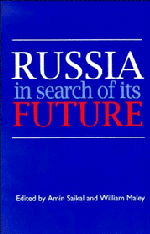Book contents
- Frontmatter
- Contents
- Preface
- Notes on Transliteration
- 1 Introduction
- Politics
- Economics
- 4 The Shape of the Russian Macroeconomy
- 5 Reforming Russian Agriculture: Privatisation in Comparative Perspective
- 6 Privatisation of Large-Scale Russian Industry
- International Relations
- Culture and Society
- Conclusion
- Notes on contributors
- Index
4 - The Shape of the Russian Macroeconomy
Published online by Cambridge University Press: 03 May 2011
- Frontmatter
- Contents
- Preface
- Notes on Transliteration
- 1 Introduction
- Politics
- Economics
- 4 The Shape of the Russian Macroeconomy
- 5 Reforming Russian Agriculture: Privatisation in Comparative Perspective
- 6 Privatisation of Large-Scale Russian Industry
- International Relations
- Culture and Society
- Conclusion
- Notes on contributors
- Index
Summary
Our century has been a harsh one for the people of Russia. Their nascent experiment with responsible government came to a screeching halt when detachments of Red Guards dissolved the Constituent Assembly in early 1918, and within three decades they were exposed to the whirlwind effects of crash industrialisation, agricultural collectivisation, the Great Terror, and the German invasion, all of which cost countless lives. With the death of Stalin in March 1953, things took a turn for the better. However, the command economy which his successors inherited, while it generated some increases in average living standards, could not match the performance of the liberated capitalist systems of Western Europe, the United States, and East Asia. This failure lay at the heart of the push for economic reform that Mikhail Gorbachev embraced during his period as General Secretary of the Communist Party of the Soviet Union from 1985 to 1991.
The larger story of Gorbachev's tenure, and of the unravelling of the Soviet Union itself, has been well told on a number of occasions, and there is no need to repeat it here. It is a dramatic and in some ways tragic tale, of a transitional leader of enormous energy whose policies acquired a momentum of their own which caused him to lose not only control of the political agenda, but even a clear sense of its shape. In no area was this more marked than that of the economy.
- Type
- Chapter
- Information
- Russia in Search of its Future , pp. 48 - 65Publisher: Cambridge University PressPrint publication year: 1994



